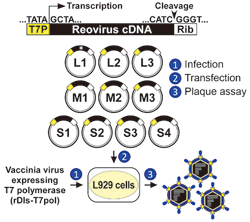Research Group
| Associate Professor (SUP) | Takeshi Kobayashi |
| SA Associate Professor | Yuta Kanai |
Research Projects

Fig1 Strategy to generate reovirus from cloned cDNA
1) Oncolytic viral therapy using reovirus
Mammalian orthoreoviruses (reoviruses) are members of the family Reoviridae and contain a genome consisting of 10 segments of double-stranded (ds) RNA. Reoviruses are highly tractable experimental models for studies of dsRNA virus replication and pathogenesis. In the last decade, the potential of reoviruses as oncolytic agents against various tumors, including head and neck, colon, breast, and pancreatic cancers, has been investigated in animal models and humans. The putative oncolytic potential of reoviruses is based on the observation that reoviruses induce cell death and apoptosis in tumor cells with an activated Ras signaling pathway. However, while wild-type reovirus-based oncolytic therapies have been safe, the efficacy so far is limited. We are thus using genetic modification to develop safer and more effective reovirus-based cancer therapeutics.
Mammalian orthoreoviruses (reoviruses) are members of the family Reoviridae and contain a genome consisting of 10 segments of double-stranded (ds) RNA. Reoviruses are highly tractable experimental models for studies of dsRNA virus replication and pathogenesis. In the last decade, the potential of reoviruses as oncolytic agents against various tumors, including head and neck, colon, breast, and pancreatic cancers, has been investigated in animal models and humans. The putative oncolytic potential of reoviruses is based on the observation that reoviruses induce cell death and apoptosis in tumor cells with an activated Ras signaling pathway. However, while wild-type reovirus-based oncolytic therapies have been safe, the efficacy so far is limited. We are thus using genetic modification to develop safer and more effective reovirus-based cancer therapeutics.
2) Highly pathogenic bat reovirus
Bats are a natural reservoir for many important zoonotic viruses, including Hendra virus, Nipah virus, and potentially SARS coronavirus and Ebola virus. In 1968, the Pteropine orthoreovirus (PRV) was isolated from flying fox. While it was not associated with any disease, Melaka virus, which is genetically similar to PRV, was recently isolated from a human patient in Malaysia with acute respiratory tract infection (RTI). Subsequently, other related strains of bat-associated orthoreoviruses have been isolated in Malaysia, Indonesia, and China. We also isolated and characterized another new PRV, Miyazaki virus, from a patient with acute RTI after returning to Japan from Indonesia in 2007. These isolates have given rise to increasing concern about bat-transmitted orthoreovirus infections in humans. We are investigating how PRV replicates and causes disease by using a combination of genetic, biochemical and biophysical approaches. Our aim is ultimately to develop vaccines, diagnostics, and therapeutics for bat reovirus-related diseases.
Bats are a natural reservoir for many important zoonotic viruses, including Hendra virus, Nipah virus, and potentially SARS coronavirus and Ebola virus. In 1968, the Pteropine orthoreovirus (PRV) was isolated from flying fox. While it was not associated with any disease, Melaka virus, which is genetically similar to PRV, was recently isolated from a human patient in Malaysia with acute respiratory tract infection (RTI). Subsequently, other related strains of bat-associated orthoreoviruses have been isolated in Malaysia, Indonesia, and China. We also isolated and characterized another new PRV, Miyazaki virus, from a patient with acute RTI after returning to Japan from Indonesia in 2007. These isolates have given rise to increasing concern about bat-transmitted orthoreovirus infections in humans. We are investigating how PRV replicates and causes disease by using a combination of genetic, biochemical and biophysical approaches. Our aim is ultimately to develop vaccines, diagnostics, and therapeutics for bat reovirus-related diseases.
Major publications
- Komoto S, Kawagishi T, Kobayashi T, Ikizler M, Iskarpatyoti J, Dermody TS, Taniguchi K. A plasmid-based reverse genetics system for mammalian orthoreoviruses driven by a plasmid-encoded T7 RNA polymerase. J Virol Methods. 2014 Feb;196:36-9.
- Boehme KW, Hammer K, Tollefson WC, Konopka-Anstadt JL, Kobayashi T, Dermody TS. Nonstructural protein σ1s mediates reovirus-induced cell cycle arrest and apoptosis. J Virol. 2013 Dec;87(23):12967-79.
- Boehme KW, Frierson JM, Konopka JL, Kobayashi T, Dermody TS. The reovirus sigma1s protein is a determinant of hematogenous but not neural virus dissemination in mice. J Virol. 2011 Nov;85(22):11781-90.
- Kobayashi T, Ooms LS, Ikizler M, Chappell JD, Dermody TS. An improved reverse genetics system for mammalian orthoreoviruses. Virology. 2010 Mar 15;398(2):194-200.
- Kobayashi T, Ooms LS, Chappell JD, Dermody TS. Identification of functional domains in reovirus replication proteins muNS and mu2. J Virol. 2009 Apr;83(7):2892-906